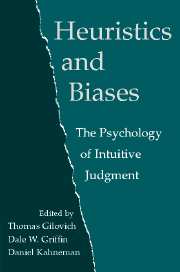Book contents
- Frontmatter
- Contents
- List of Contributors
- Preface
- Introduction – Heuristics and Biases: Then and Now
- PART ONE THEORETICAL AND EMPIRICAL EXTENSIONS
- PART TWO NEW THEORETICAL DIRECTIONS
- 22 Two Systems of Reasoning
- 23 The Affect Heuristic
- 24 Individual Differences in Reasoning: Implications for the Rationality Debate?
- 25 Support Theory: A Nonextensional Representation of Subjective Probability
- 26 Unpacking, Repacking, and Anchoring: Advances in Support Theory
- 27 Remarks on Support Theory: Recent Advances and Future Directions
- 28 The Use of Statistical Heuristics in Everyday Inductive Reasoning
- 29 Feelings as Information: Moods Influence Judgments and Processing Strategies
- 30 Automated Choice Heuristics
- 31 How Good Are Fast and Frugal Heuristics?
- 32 Intuitive Politicians, Theologians, and Prosecutors: Exploring the Empirical Implications of Deviant Functionalist Metaphors
- PART THREE REAL-WORLD APPLICATIONS
- References
- Index
22 - Two Systems of Reasoning
from PART TWO - NEW THEORETICAL DIRECTIONS
Published online by Cambridge University Press: 05 June 2012
- Frontmatter
- Contents
- List of Contributors
- Preface
- Introduction – Heuristics and Biases: Then and Now
- PART ONE THEORETICAL AND EMPIRICAL EXTENSIONS
- PART TWO NEW THEORETICAL DIRECTIONS
- 22 Two Systems of Reasoning
- 23 The Affect Heuristic
- 24 Individual Differences in Reasoning: Implications for the Rationality Debate?
- 25 Support Theory: A Nonextensional Representation of Subjective Probability
- 26 Unpacking, Repacking, and Anchoring: Advances in Support Theory
- 27 Remarks on Support Theory: Recent Advances and Future Directions
- 28 The Use of Statistical Heuristics in Everyday Inductive Reasoning
- 29 Feelings as Information: Moods Influence Judgments and Processing Strategies
- 30 Automated Choice Heuristics
- 31 How Good Are Fast and Frugal Heuristics?
- 32 Intuitive Politicians, Theologians, and Prosecutors: Exploring the Empirical Implications of Deviant Functionalist Metaphors
- PART THREE REAL-WORLD APPLICATIONS
- References
- Index
Summary
THE EMPIRICAL CASE FOR TWO SYSTEMS OF REASONING
The stimulation from a classic paper in the heuristics and biases tradition does not come only from the insights provided into processes of judgment and decision making; it also comes from anxiety, from the tension introduced between immediate intuition and more measured rational belief. Clearly, there is a limit to how much one's interest is piqued by reading about other people's mistakes. It is our own mistakes, and the insights they bring, that are so arresting and compelling. The tension is revealing because it reflects a gap within our own heads between, on one hand, our intuitions and, on the other hand, those of our beliefs that we consider rational. The classic demonstrations often suggest two minds at work: one following the “natural assessment methods” like representativeness and availability; and the other working to form coherent, justifiable sets of beliefs and plans of action. As Tversky and Kahneman have repeatedly shown, the two minds do not always agree.
The distinction between these two minds can be construed in terms of one of the central puzzles in experimental psychology – whether people are best conceived as parallel processors of information who operate along diffuse associative links, or as analysts who operate by deliberate and sequential manipulation of internal representations. Do we draw inferences through a network of learned associative pathways or by applying some kind of psycho-logic that manipulates symbolic tokens in a rule-governed manner?
- Type
- Chapter
- Information
- Heuristics and BiasesThe Psychology of Intuitive Judgment, pp. 379 - 396Publisher: Cambridge University PressPrint publication year: 2002
- 164
- Cited by

